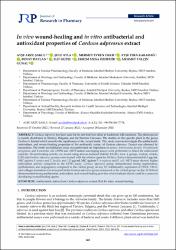| dc.contributor.author | Şakul, Ayşe Arzu | |
| dc.contributor.author | Ayla, Şule | |
| dc.contributor.author | Okur, Mehmet Evren | |
| dc.contributor.author | Karadağ, Ayşe Esra | |
| dc.contributor.author | Daylan, Benay | |
| dc.contributor.author | Güzel, Elif | |
| dc.contributor.author | Özdemir, Ekrem Musa | |
| dc.contributor.author | Günal, Mehmet Yalçın | |
| dc.date.accessioned | 2023-04-18T06:43:36Z | |
| dc.date.available | 2023-04-18T06:43:36Z | |
| dc.date.issued | 2023 | en_US |
| dc.identifier.citation | Şakul, A. A., Ayla, Ş., Okur, M. E., Karadağ, A. E., Daylan, B., Güzel, E. ... Günal, M. Y. (2023). In vivo wound-healing and in vitro antibacterial and antioxidant properties of Carduus adpressus extract. Journal of Research in Pharmacy, 27(2), 665-676. https://dx.doi.org/10.29228/jrp.349 | en_US |
| dc.identifier.issn | 2630-6344 | |
| dc.identifier.uri | https://dx.doi.org/10.29228/jrp.349 | |
| dc.identifier.uri | https://hdl.handle.net/20.500.12511/10875 | |
| dc.description.abstract | Carduus adpressus has been used for its anti-hair loss effect in traditional folk medicine. The plant species is mainly distributed in Türkiye, Bulgaria, and the Western Caucasus. The studies on this specific plant in the genus Carduus is limited which remarks the significance of the current study. This study aims to investigate the antibacterial, antioxidant, and wound-healing properties of the methanolic extract of Carduus adpressus. Extract was obtained by maceration. The broth microdilution assay was performed on Staphylococcus aureus, Enterococcus faecalis, Pseudomonas aeruginosa, and Escherichia coli. DPPH and ABTS radical scavenging assays were performed to detect the antioxidant capacity. Wound-healing activity was tested using alloxan-induced diabetic BALB-c mice. 4 groups, control, vehicle, CAE and Carduus adpressus groups were treated with the relative agent for 10 days. Extract demonstrated 62.5 µg/mL MIC against S. aureus and E. faecalis, and 125 µg/mL MIC against P. aeruginosa and E. coli. ABTS assay showed higher antioxidant activity compared to the DPPH assay. Carduus adpressus group demonstrated strong regeneration, epithelisation, and angiogenesis compared to the control group on day 10. Additionally, expression of PDGF, VEGF, and collagen formation was increased in the Carduus adpressus group compared to the control group on day 10. Extract demonstrated strong antibacterial, antioxidant, and wound-healing activities which indicate that it could be a source in developing wound-healing agents. | en_US |
| dc.language.iso | eng | en_US |
| dc.publisher | Marmara University | en_US |
| dc.rights | info:eu-repo/semantics/openAccess | en_US |
| dc.subject | Antibacterial | en_US |
| dc.subject | Antioxidant | en_US |
| dc.subject | BALB-C Mice | en_US |
| dc.subject | Carduus Adpressus | en_US |
| dc.subject | Extract | en_US |
| dc.subject | Wound-Healing | en_US |
| dc.title | In vivo wound-healing and in vitro antibacterial and antioxidant properties of Carduus adpressus extract | en_US |
| dc.type | article | en_US |
| dc.relation.ispartof | Journal of Research in Pharmacy | en_US |
| dc.department | İstanbul Medipol Üniversitesi, Tıp Fakültesi, Dahili Tıp Bilimleri Bölümü, Tıbbi Farmakoloji Ana Bilim Dalı | en_US |
| dc.department | İstanbul Medipol Üniversitesi, Eczacılık Fakültesi, Eczacılık Meslek Bilimleri Bölümü, Farmakognozi Ana Bilim Dalı | en_US |
| dc.department | İstanbul Medipol Üniversitesi, Rektörlük, Sağlık Bilim ve Teknolojileri Araştırma Enstitüsü | en_US |
| dc.authorid | 0000-0002-9354-0000 | en_US |
| dc.authorid | 0000-0002-3412-0807 | en_US |
| dc.authorid | 0000-0002-2737-0568 | en_US |
| dc.authorid | 0000-0001-9416-7757 | en_US |
| dc.identifier.volume | 27 | en_US |
| dc.identifier.issue | 2 | en_US |
| dc.identifier.startpage | 665 | en_US |
| dc.identifier.endpage | 676 | en_US |
| dc.relation.publicationcategory | Makale - Uluslararası Hakemli Dergi - Kurum Öğretim Elemanı | en_US |
| dc.identifier.doi | 10.29228/jrp.349 | en_US |
| dc.institutionauthor | Şakul, Ayşe Arzu | |
| dc.institutionauthor | Karadağ, Ayşe Esra | |
| dc.institutionauthor | Güzel, Elif | |
| dc.institutionauthor | Özdemir, Ekrem Musa | |
| dc.identifier.scopus | 2-s2.0-85151389912 | en_US |
| dc.identifier.trdizinid | 1177583 | en_US |
| dc.identifier.scopusquality | Q3 | en_US |


















